BR(W) steam loco livery 1948–64

John Copsey, Dick Riley and David Tipper introduced their article in GWRJ issue number 7 with the dictum: "The 1940s and early 1950s were perhaps the most disordered period ever encountered in terms of engine liveries". As an example of this disorder, Stars were normally lined, but here is 4025 in unlined green, pictured on 28 December 1948. The Collett 4000g tender displays its insignia in GWR Egyptian font. The loco's previous nameplate had been removed in 1940. Prior to this 1948 repaint, 4025 had been in wartime black, thought to have been applied between 13 February and 21 March 1943. Photo by Ben Brooksbank.
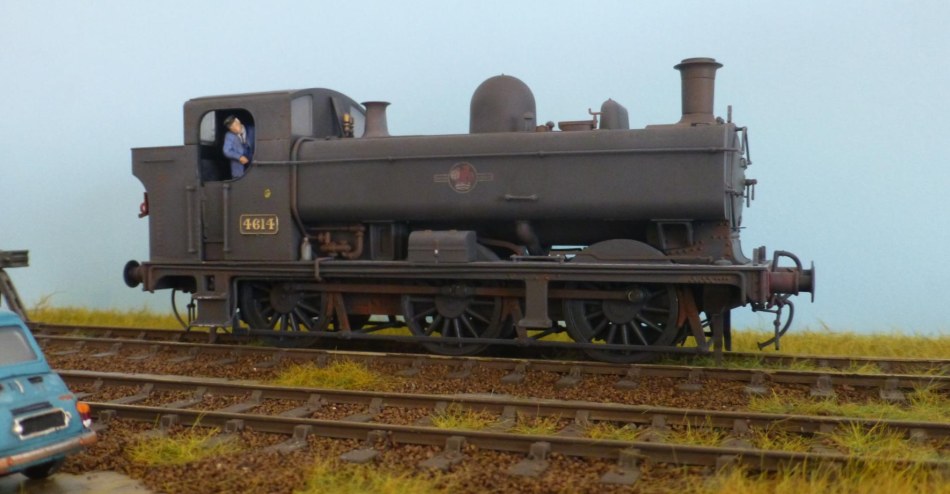
One of Minerva's 7mm Panniers, superbly weathered by James Harrison to represent 4614 in its last years working in the Forest of Dean

A Bachmann 4mm 64xx in late-totem lined green, nicely weathered by Chris Hopper

Ted Kanas' Saint 7mm 'Clevedon Court' in lined BR(W) mixed-traffic black livery

Ted Kanas' outside-cylindered dock tank 1368, in post-1957 unlined black livery. It was very rare to see a red background numberplate at this late stage with the late crest, but it is correct.

Manor 7811 in plain black livery at Swindon, 6 May 1950. The background of the plates should be red at this date, but they are black. (It is possible the picture is wrongly dated.)
Introduction
The post-nationalisation steam liveries can be roughly divided into two short eras, 1948–56, and 1956–1965, when Western Region steam came to an end. The liveries in both these eras show rapid change, are not always logical, and the variations described endorse the old adage of following a dated picture if historical modelling accuracy is to be observed. As always, locos were usually repainted only after major shoppings, so liveries overlapped even within the same class, and many locos went for scrap in the late 1950s and early 1960s still in pre-1956 paint.
Thanks are extended to members of RMweb for help in compiling these notes.
General body colours, and lining application
1948–1956
Nationalisation commenced on 1 January 1948, but livery change was gradual and muddled. It was decided that locos should continue to be painted in their pre-nationalisation style pending a decision on insignia. Locomotives therefore continued to be turned out initially in GWR 1946 livery except that company lettering was omitted pending a specification for the new lettering. From mid-January, as an interim measure, 'BRITISH RAILWAYS' in GWR Egyptian font was being applied to the sides of tenders and tanks. Kings, Castles and Stars continued to be outshopped in lined green livery, in much the same previous style, but there were differences in lining style, as detailed below.
Experimental liveries appeared in 1948 on some express locos: lined apple green, and lined dark blue for Kings 6001, 6009, 6025 and 6026. The lined apple green experiment was confined to Castles – 4091, 7010, 7011, 7012 and 7013 painted from new, with 4089, 4091, 5010, 5021 and 5023 receiving the livery following works overhaul. Kings were painted in a lined lighter blue livery from 1949, but they began to revert to green from 1951.
Other than Kings, Castles and Stars, classes that were lined previously in GWR days began to be outshopped in a 'mixed-traffic and secondary passenger' lined livery, which first started to make its appearance in 1949. The classes involved were therefore Halls, Counties, and those Saints (2920/6/7/34/7/45/7/9/54) receiving works repaints before the class finally disappeared in October 1953. In addition, the ten BR-built Manors (7820–7829) received the livery. Body colour was black, and lining on tanks and tender sides was a ⅝" outer pale dove grey band adjacent to which was an inner ⅛" cream band, inside which was a ⅛" red line. Lining on boiler bands and cylinders was two ⅛" red lines. Mixed-traffic livery locos retained their copper chimney tops and brass safety valve covers. It should be noted that this livery era lasted only from 1949–56, and some Halls (e.g. 6990) carried their pre-1949 lined green livery right through to 1956, when lined green livery was re-introduced, so never received the lined black livery.
All locos other than Kings, Castles, Stars, Saints, Halls, Counties and the 10 BR-built Manors were outshopped in unlined black. The decision to used unlined black for 'non-express' locos had in fact been made in principle at the Riddles/BTC agreement of October 1947, but it seems it wasn't until the Gill Sans lettering for 'BRITISH RAILWAYS' arrived (June 1948) that black began to be used.
7804 Baydon Manor received unlined green with no emblem on the tender in 1948 for pilot duties over the south Devon banks. Between 1952 and 1954 it received unlined black with early crest, probably at the same time as the blastpipe modifications. The BR-built Manors, painted in lined mixed traffic black with the early crest when new, reverted to unlined black with the early crest during 1952–4 (probably at the same time as the blastpipe modifications). Prior to 1949, a few large Prairies appeared in unlined green, including 4162.
For the less-distinguished classes, there were exceptions to the general application of unlined black. The following locos are examples of lined black:
- 0-4-2Ts 1411, 1417, 1465, 1470, 5816
- Collett Goods 0-6-0 2213, 2238
- Dean Goods 0-6-0 2529, 2579
- 2-8-0 4702
- Panniers 1503–5, 5409, 8762–4/71/3
- Moguls 5370, 6323, 7313, 9314
- Dukedogs 9009 and 9014
- small Prairies 4406, 4409 (with BRITISH RAILWAYS insignia), 5527
- large Prairies 4116, 4146, 4166, 4167 (note no insignia), 4171, 4177, 4179, 5156, 5173, 5190, 5192
- Manors 7820–7829
- two Granges, 6819, and probably 6809
For locos in plain black or lined mixed-traffic black livery, the background colour of nameplates and numberplates was painted red from November 1949. This practice ceased in April 1952, when the background reverted to black on official repaints. Newton Abbot works however continued to paint name and number plates with a red background for at least two years after the practice had been officially discontinued. Some engines could still be seen with red-background number plates up to 1960/1.
For green bodywork locos and tenders, the perimeter beading on the top of tender fenders and the beading of the cabside cutout was green.
Some odd loco-tender livery pairings took place: 6947 in lined black loco with a GWR shirtbutton tender (April 1953), 6994 in lined black with a G [crest] W green tender, Castle 5012 with a lined black tender, 4708 in black paired with a green 4000g tender with Egyptian style 'British Railways' insignia.
1956–1964
In anticipation of a future relaxing of the rules, green was re-introduced in 1955 for locos other than Kings, Castles and Stars, and appeared first on some Counties. The introduction of lined green for non-express locos was sporadic, but can be dated to approximately March 1956. The following are examples, other than Kings, Castles and Stars of course, of lined green with early crests:
- Counties 1000, 1003 1, 1010 2, 1013, 1016, 1017, 1025 and 1026
- Halls 4918, 4981, 5907, 6991, 6994, 6997 and 7904
- Moguls 4358, 5376, 6372 and 6385
- Manors 7801, 7805, 7810 and 7828
- Granges 6818, 6840 and 6855
- large Prairies 4134, 4167 and 6135
- small Prairies 4547, 4562 (small crest), 4570, 4571, 4585, 4587, 5519, 5528 and 5536
- Panniers 5420, 5423 and 6421
- 0-4-2Ts 1444, 1453 and 1454
- Collett Goods 2207 and 2239
| Lined green with an early crest was a rare combination on a large Prairie. 6135 at Swindon on 3 March 1956. The safety valve cover is painted over, but would appear later looking like it has been painted brass |
 |
The first era of unlined green appeared between late 1956 and early 1957, but was confined to a relatively few number of locos outshopped from Caerphilly works, including small Prairie 4569, large Prairies 4121, 4160, 5169 and 8103, 0-6-2Ts 5635, 5641, 5656, 5662, 5677, 6605, 6609 and 6680, with lion and wheel crests. Moguls 5311, 6306, 6326 and 7300 are also thought to have been in unlined green c April 1957, 6397 was in unlined green with a large early crest in July 1957, and 1454 was in unlined green early crest in April 1957.
The first official instruction regarding application of green livery, either lined for certain mainline passenger engines or unlined for smaller passenger and mixed traffic engines, was issued in November 1956. The next instruction, issued on 25 January 1957, rescinded the previous instruction, and stated that all engines painted green were to be lined out. An additional complexity was that lining was to be applied not only to passenger classes, but also many 'passenger' members of classes not previously lined in GWR days. These included:
- Manors
- Granges
- 47xx class
- many of the large Prairies
- small Prairies, including 4547, 4552, 4557, 4561, 4562, 4564, 4565, 4566, 4567, 4569, 4570, 4571, 4574, 4585, 4587, 4589, 4591, 4593, 4594, 5504, 5510, 5514, 5519, 5523, 5528, 5531, 5534, 5536, 5539, 5542, 5545, 5549, 5551, 5554, 5555, 5560, 5562, 5563, 5569, 5570, 5571 and 5572
- many 14xx 0-4-2T locos
- Moguls, including 4358, 5322, 5326, 5330, 5339, 5357, 5358, 5369, 5370, 5376, 5396, 5398, 6301, 6304, 6308, 6313, 6333, 6337, 6339, 6343, 6346, 6347, 6351, 6352, 6353, 6355, 6364, 6365, 6372, 6374, 6377, 6379, 6385, 6389, 6391, 6394, 7307, 7309, 7310, 7316, 7326, 7330, 7333, 7334 and 7341
- some passenger 54xx and 64xx Pannier tanks – examples are 5409, 5410, 5416, 5420, 6400, 6412, 6416, 6418, 6421, 6430 and 6437
- 0-6-2T (56xx, 66xx) locos, e.g. 5600, 5604, 5614, 5617, 5619, 5621, 5626, 5627, 5628, 5632, 5643, 5644, 5645, 5647, 5653, 5654, 5668, 5674, 5680, 5682, 5685, 5686, 5689, 5692, 6603, 6613, 6616, 6618, 6619, 6624, 6635, 6641, 6642, 6651, 6652, 6656, 6657, 6659, 6661, 6664, 6665, 6683, 6688, 6689, 6670, 6671, 6688, 6689, 6691, 6694 and 6695
- some Collett Goods locos (2251 class), including 2201, 2204, 2207, 2211, 2212, 2217, 2219, 2220, 2230, 2231, 2232, 2239, 2241, 2251, 2255, 2268, 2277, 2286, 3200, 3203, 3205, 3206, 3210, 3215 and 3216
The first Halls to appear in green (lined, with early crest), after heavy overhauls between Spring 1956 and Spring 1957, included: 4904, 4910, 4914, 4918, 4926, 4930, 4931, 4949, 4962, 5910, 5919, 5938, 5957, 5962, 5990, 6929, 6945, 6961, 6962, 6963, 6964, 6969, 6971, 6973, 6979, 6991, 7906, 7912, 7920 and 7925. 5960 appeared as a lined black loco coupled to an early crest lined green tender.
Boiler feed pipes were lined on some Halls, Granges and Collett-series Moguls (i.e. those with side windows), but not for other classes. The lining in these cases was a single orange line in the middle of the boiler feed pipe cladding.
Generally, the fender of Churchward 3500g tenders was not lined, but a few were, primarily a quirk of Caerphilly. Churchward 3500g tenders with lined fenders were seen behind Moguls 4358, 6364, 6372, 6385, 6389 and Manors 7801 and 7810. One tender, seen running behind Mogul 6308 in February 1957, had a single lining panel applied incorrectly, with the upper part of the panel extending to the fender area. Officially, lining of the fender on such tenders was discontinued in July 1957.
Lining was not applied to the rear face of tender bodies, although could still be seen, as a continuation of the GWR style, on tenders newly relettered with 'British Railways' in Egyptian font in 1948.
Generally, no effort was made to remove paint from previously painted safety valves, but exceptions to this could be observed. In 1957–8, Caerphilly works polished (as opposed to painted) all brass safety valve covers, even on engines painted black.
For locos in green, the valance was painted green. The green valance was also applied to tenders running with green locos.
Caerphilly works had a fondness for painting reversing rods red, but was instructed by Swindon to cease the practice in November 1958. (The last loco to have its reversing rod painted red was 6345 at the end of October 1958.)
A second period of unlined green was the so-called 'economy green' era, and seems to have started possibly as early as 1958 and certainly by 1960. It has been recorded on Moguls 5306, 5369, 6320, 6327, 6363, 6368, 6378, 6381, 6384, 7304, 7306, 7317, 7320, 7326, 7337 and 7340, and was also applied to small Prairies 4574, 5537, 5557 and 5569, some large Prairies, e.g. 6106, 6111, 6129, 6136, 6141, 6147, and 6167, some 56xx locos, some 2251s and some 14xxs. Some locos received plain black in their last years.
After 1958, the numbers of steam locos receiving works attention and repainting declined rapidly, and as a consequence the standard of external cleanliness of steam locos also declined dramatically. Labour shortages at sheds meant that the majority of locos, except for a few express passenger locos, were cleaned rarely if at all. The external state of many locos in their last years was pitiful, with no insignia discernible beneath the heavy grime.

4mm Bachmann Pannier 7768 in typical everyday weathered state, built and painted by John Brighton

1401 in plain black livery with a small early crest. The loco found fame in the 1953 film 'The Titfield Thunderbolt'

4695 at Stafford Road, 11 September 1960, with a shiny safety valve bonnet. BR(W) insignia on 57xx/8750 panniers were commonly offset toward the rear of the tank, aligning above the toolbox. This positioning however is dependent on era, and insignia placed centrally on the tank could also be seen.
Lining details
- Cylinder lining continued to be twin ⅛" lines, either orange chrome for the green-bodied locos or red for black-bodied locos, but was no longer formed into a panel shape.
- For boiler bands on green-bodied locos, the previous ½" space between the 1" black line and the ⅛" chrome orange lines was increased to ⅝" (see graphic adjacent).
- No lining was applied to bufferbeams or valances below the footplate.
- Lining was not applied to the front of cabs.
- From 1 June 1948, lining was omitted from firebox bands.
- From 1 June 1948, for locos with cab side windows, cab side lining no longer continued above the window.
|
 |

| 5973 Rolleston Hall in lined black livery, ex-works at Swindon, showing the cabside and splasher lining, the positioning of the route and power indicator disc, and the absence of lining on the firebox. The background of the nameplate and lined numberplate is black. |
 |

5101, in late totem lined green, with a painted over safety valve cover. On the large Prairies, the route and power indicator disc was located below the numberplate on the left-hand side when steps were fitted after 1952, but before the steps were fitted could be seen either above or below the numberplate. The large size of early crest and totem was the norm for large Prairies, but small versions of the crest and totem could be seen.
Lining on the flat-top small Prairies did not impinge on the cab shutter area, but on the sloping-tank 4575s, the shutter would normally obscure a section of the lining. The painters at Newton Abbot works got a bit 'creative' and invented a unique variation, which was applied to a number of 45xx, 4575, 5101 and 56xx locos, in both early and late crests. 5562 here has a rare right-facing late crest. 4585, 5503, 5519, 5536 and 5570 carried the same lining style.
Note the black valance on 5562. |
 |
There is a question mark over the colour of cab doors on green-bodied tank engines. Some works grey portraits dating back to earlier (GWR) days do show cab doors darker than general bodywork. That however might have been a works grey convention, in the same way that brakes, frames and wheel centres were differentiated colourwise.
Current preservation practice varies, particularly on large Prairies.
(Image extract courtesy Gareth Price.) |
 |
In May 1956, several months before lined green became the new BR(W) policy for mixed-traffic locos, Moguls 6372 and 6385 were turned out in lined green for Royal Train duties on the Barnstaple branch. The fenders of their Churchward 3500g tenders were lined. The lining precluded large size early crests, so small early crests were used. Given that lined green started to appear as a norm only in early 1957, and the instruction to cease lining fenders was in July 1957, the number of tenders with lined fenders was probably very few.
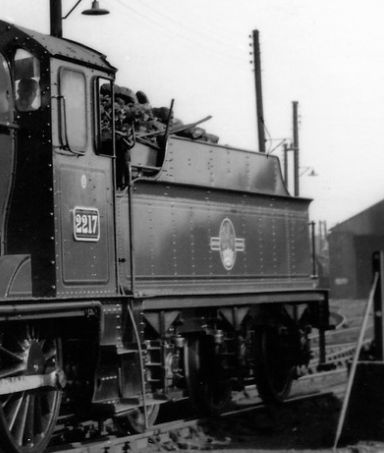
An early Dean 3000g with lining, behind Collett Goods 2217 at Shrewsbury |
 |
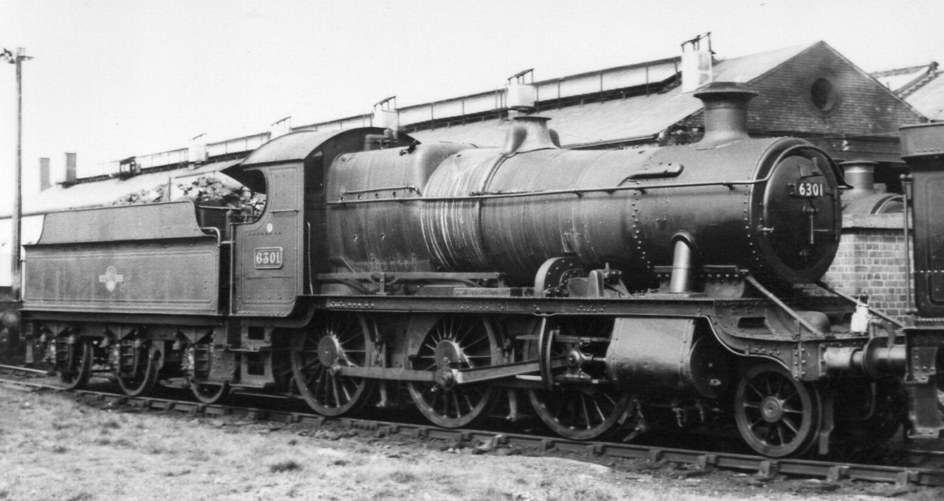
Mogul 6301 in lined green livery, which it probably acquired in March 1958 when the loco was fitted with outside steam pipes. The fender of the tender is not lined. A year later, the loco would be seen holed up in Laira shed coupled to a large crest unlined black tender.
Insignia
For a short initial period in 1948–9, insignia changed to 'BRITISH RAILWAYS' on tank and tender sides:
- Initially, from 1 January 1948 to 31 May 1948, this was in the standard shaded yellow GWR Egyptian font. Examples are 39, 41, 64, 77, 83, 91, 111, 208, 211, 215, 270, 295, 335, 337, 361, 666, 893, 895, 1014, 1016, 1017, 1021, 1022, 1027, 1542, 2001, 2089, 2146, 2219, 2223, 2286, 3178, 3636, 3694, 3726, 4017, 4022, 4025, 4026, 4037, 4039, 4050, 4078, 4085, 4099, 4100, 4160–65, 4229, 4298, 4404, 4546, 4571, 4902, 4919 (loco in lined black), 4925, 4928, 4941, 4946, 4951, 4972 (loco in lined black, lined green tender), 4977, 5017, 5018, 5019, 5022, 5035, 5037, 5048, 5059, 5067, 5068 (8-wheeled tender), 5072, 5077, 5079, 5095, 5099, 5112, 5144, 5165, 5197, 5218, 5415, 5514, 5602, 5624, 5691, 5699, 5904 (loco and tender in unlined green), 5972 (in lined black), 5976, 6003, 6017, 6126, 6141, 6160, 6308, 6321, 6411, 6658, 6696, 6697, 6698, 6866, 6911, 6964 (loco in black, tender in lined green), 6977, 6984, 6986, 6987, 6988, 6999, 7003, 7007, 7008, 7009, 7014, 7017, 7213, 7225, 8100, 8738, 8767, 7914 and 9741. The following lined black Halls were paired, as part of normal tender swapping, with green tenders with GWR Egyptian font 'BRITISH RAILWAYS': 4919, 5901 and 5997.
- Later (from 1 June 1948 to 31 March 1949), a 6" Gill Sans font was adopted, but opinions differ as to whether the colour was white or light cream. Examples are 40, 42, 46, 56, 68, 73, 75, 81, 203, 236, 240, 284, 306, 309, 312, 351, 360, 372, 398, 1421, 2100, 2109, 2115, 2148, 2238, 2351, 3738, 4091 (in experimental light green livery), 4143, 4146, 4215, 4241, 4235, 4272, 4276, 4409, 4505, 4526, 4591, 5010 (in experimental light green livery), 5021, 5023, 5106, 5155, 5169, 5180, 5190, 5202, 5216, 5221, 5236, 5241, 5262, 5519, 5523, 5534, 5613, 5644, 5645, 5670, 5697, 5699, 6001, 6025 (in blue livery), 6602, 6614, 6662, 6682, 6684, 6685, 6910, 7010 (in apple green livery), 7011 (in apple green livery), 7203, 7224, 8105, 8773 and 9715.
(5816 appeared for a short period with a sans serif font, but not Gill Sans.)
Prior to the availability of the first lion and wheel crests, some large Prairies were outshopped in unlined green, with GWR style numerals on their bufferbeams, and a small (2") white W under the cabside numberplate. The 'W' was applied between January and late March/early April 1948, and it is thought about 150 or so GWR engines received it.
The Gill Sans lettering used by BR varied slightly. Transfers were derived from hand-drawn lettering, which was not as precise as a modern-day computer-based font. Different kernings were used in the transfer sets. The lettering style used by Caerphilly was slightly bolder and in some respects closer to the Grotesque font used prior to 1948. A comparison of Gill Sans and Grotesque is adjacent, courtesy of Phil Martin, and is available as a pdf
Examples of Gill Sans on large Prairies are 4146 and 5180. |
 |
'BRITISH RAILWAYS' in GWR Egyptian font on an 8'-wide 4000g Hawksworth tender behind Castle 7017 'G J Churchward' in early 1948.
For the first six months of nationalisation, lining was still applied to fireboxes, and cabside lining continued in GWR style. This would change when Gill Sans insignia was adopted. Lining was however no longer applied to the valance, but this was still in black, as per GWR days. |
 |
| 4404 at Tondu on 28 August 1948 |
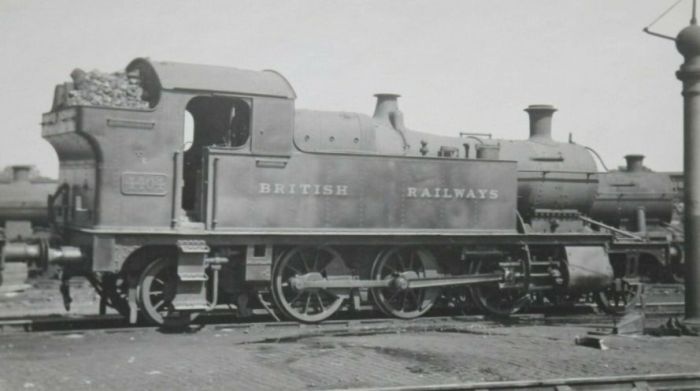 |

A very grubby 5519 at St Blazey shed on 26 June 1950
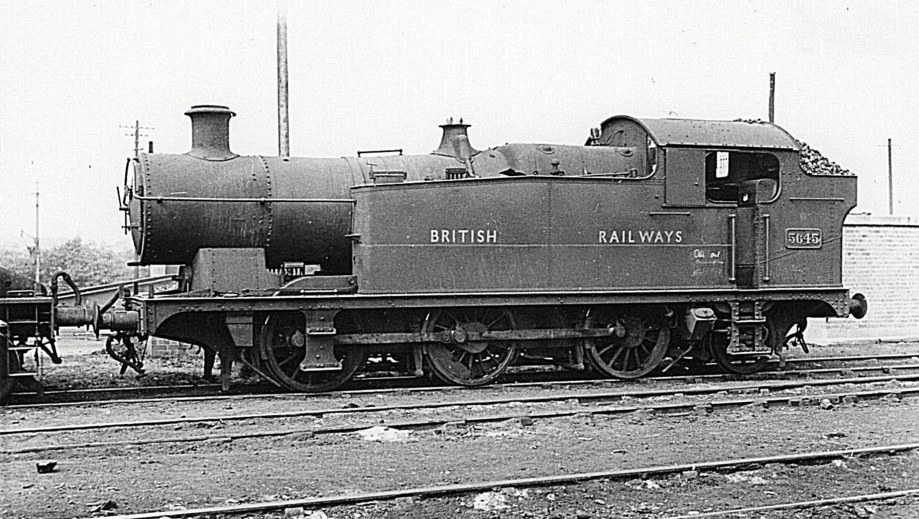
0-6-2T 5645 with white Gill Sans 'BRITISH RAILWAYS' insignia. The safety valve cover should be a tall one, to align with the height of the valves, but a short cover has been fitted.

0-6-2T 6682 with 'BRITISH RAILWAYS'. This lettering is the work of Caerphilly, and the font is slightly bolder than other Gill Sans transfer sets, and in some respects is closer to the Grotesque font used by Caerphilly prior to 1948.
| With recently-applied Gill Sans 'British Railways' insignia, and shortly before it was renumbered 438, 309 is a heavily-Swindonised ex-TVR 04 class 0-6-2T, originally built in 1914 by Hawthorn Leslie & Co. It was withdrawn in 1953. |
 |
The BR lion & wheel insignia first appeared (on Castle 7018) in May 1949. Two forms of this insignia were produced, left and right, the idea being for the lion to face the front of the loco. Shortages of the insignia however meant that some locos had lions facing the wrong way round, or the insignia was not applied on occasion if the correct form was not available. There were three sizes of this insignia, 26.5" wide, 15" wide and 8.5" wide, although the latter appear to be scarce.
Locos were still being outshopped with this crest in February 1957, and probably some time after this, using up stocks of the old insignia. (An example is Prairie 5189, which appeared with lining and a small lion & wheel crest.)
Newton Abbot works continued to use up its stocks of early crest transfers for 18 months or more after the late crest had been introduced. |
 |
| The lion & wheel insignia was replaced with the BR 'ferret and dartboard' totem in 1957. Initially, this was also produced in left- and right-hand versions, but a dispute with the College of Arms meant that BR(W) was forced to use only the version it had registered, which was the one facing left. The totem existed in two sizes, 43.75" wide and 30.25" wide. |
 |
| Large early crest on a 4000g tender behind Castle 4000 (rebuilt from the prototype Star). The tender underframe has short hangars, long gussets and wide hornguides. |
 |
 |
 |
Unavailability of lettering/insignia, or awaiting new stocks, meant that locos were occasionally let loose without markings, as in the case of Star 4040 at Chippenham in lined green (probably in 1948) and Hall 6916 in lined BR black at Gloucester (probably in 1949). |
| The GWR power and route restriction indicators continued to be displayed, but the 57xx and 8750 class of Panniers were all re-classified in 1950 as 'Yellow' route engines rather than their previous blue category. For locos whose indicators had been lowered during WWII, the position of the indicators remained above the numberplate, and they were not raised up to their pre-war position high on the cab sheet. For unclassified weight (uncoloured) locos painted in black, the power class letter was not normally applied: known exceptions to this were 16xx Panniers 1607/8/13/20/23/27/30/31/34/36/38/39/40/43/44/46/47/48/49/51/59/61/64, which had a white A applied, and some early 'lion & wheel' repaints, where the white A had a white circle. Generally the white A did not reappear on post-1957 'ferret and dartboard' repaints. |
 |
Loco numbers on buffer beams were no longer applied, but were still to be seen for many years after nationalisation. All locos carried steel number plates on the front of the smokebox door, the 5" numbers being in BR Gill font. These number plates were in black, with the numbers picked out in white. The corners of the plate were slightly rounded. The 1'9" length also applied to 2- and 3-digit numbers. The plates were ostensibly 5⅞" high, but casting variations could make the height nearer 6".
Smokebox plates were generally fitted at the same a loco received its first BR(W livery; however, some locos repainted shortly before 1948 received smokebox numberplates whilst awaiting their next repaint. |
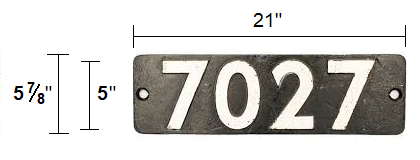 |
| Elliptical (7.25" x 4.5") cast steel shed plates were applied to the bottom of the smokebox door, and replaced the three-character code painted on the front of the footplate valance, which was discontinued from January 1950. The characters and the rim of the shed plates were picked out in white. The numerals are approximately 2" high, and the letter is approximately 1.5" high. |

image courtesy Railwayana Auctions UK |
| Except for the words on the tank sides, newly-outshopped 9741 is in the same style as it would have been finished in late GWR days, with green bodywork and GWR numerals on the bufferbeams. The date of this picture (at Stafford Road) is in the first few months of 1948, and it will probably be a while before it receives its new cast smokebox door numberplate. |

|
It seems the arrival of lettering in Gill Sans font in June 1948 marked the end of smaller locos receiving green bodywork, so this tank is in black.
The kerning of the lettering here is a lot tighter than was commonly shown in other Gill Sans transfers. |
 |
| It was common for tank locos to receive their BR smokebox numberplates whilst still carrying GWR livery, as on 9707, at Old Oak Common. |
 |

5802 has received a front-end and chassis repaint (commonly referred to as a 'heel and toe') following a works visit, but the rest of body remains in the state it had during GWR days. Swindon, 21 June 1958.

Some locos lasted long enough to receive overhead electrification warnings. 9663 at Shrewsbury, April 1962

An intentionally over-exposed shot showing the colouring of the controls and fitments inside the cab of Pannier 5764
Further reading:
Ian Rathbone's comprehensive British Railways Western Region locomotive liveries 1948 – 1955
1 Photo dated 1955 in Portraits of Western 4-6-0s by Holden and Leech
2 Photo dated 26 June 1955 in The Great Western Remembered by Whiteley and Morrison
|







































